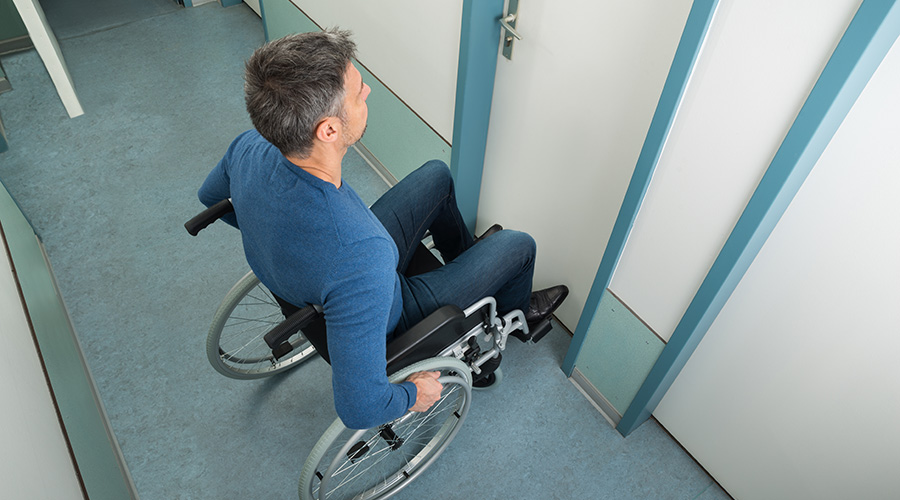Whole-Building Access
To provide complete accessibility, managers need to understand ADA and evaluate their facilities
Restrooms generally receive the lion’s share of organizations’ attention — and sometimes cost, as well — in efforts to ensure the accessibility of facilities. But before visitors ever get to a building’s restrooms, they often are confronted by challenges related to other facility components: entrance doors, ramps, water fountains, handrails, wheelchair lifts and elevators.
Visitors with disabilities often must travel long distances before even getting to the restrooms, and those paths must be free of barriers.
Understanding Priorities
When the Americans with Disabilities Act (ADA) was written and the technical and scoping requirements developed by the U.S. Access Board, certain baseline requirements had to be understood. These requirements were based on a common-sense approach to the way someone with a disability would encounter and use a facility.
ADA set forth its barrier-removal priorities for owners and managers to follow in their barrier-removal efforts. They are, with the highest priority first:
-
getting through the door
-
getting access to the goods and services provided in the facility
-
getting access to restrooms
-
addressing other barriers such as water fountains, pay phones, and alarms.
Managers need to remember several key items when talking about the barrier removal process. The requirement to perform “readily-achievable barrier removal” in all existing buildings — those designed and constructed before 1993— began on Jan. 26, 1992. The process was supposed to be ongoing, and facilities designed and built after ADA’s implementation must comply with the higher new-construction requirements.
Status Check
In general, managers cannot know precisely what they will have to change, add or build until they understand existing conditions. The same is absolutely true for ADA compliance and usability for people with disabilities. If a facility was built to code before 1992, chances are very good that a number of the elements do not comply with the current ADA requirements and require modifications.
Managers next must evaluate facilities first, and doing that requires skill and knowledge of ADA’s specific requirements. A professional comprehensive review of a facility will help managers understand the items that need to be modified and others might not.
Getting Through the Door
The first ADA priority is getting visitors and occupants through the door. Many facilities have multiple entrances and multiple doors at an entrance, often including revolving doors.
Most exterior hinged doors also are too heavy to open for people with disabilities, as well as for older people and those with their arms full of packages. ADA has no requirement for the amount of force that is required to open or close exterior doors, although some states and local codes do have such requirements. ADA does have a number of other requirements for exterior doors, so managers have a number of issues to consider when evaluating the accessibility of these components:
-
If the facility has multiple entrances and the main entrance is not accessible, consider installing directional signage, using the international symbol of accessibility, to the accessible entrance, if one exists.
-
If the facility has no accessible entrance, get to work on it.
-
If the entrance has revolving doors and hinged doors, place the international symbol of accessibility at the hinged door confirming that revolving doors are not accessible.
-
Ensure that hinged doors meet ADA requirements. For reference, go to www.ada.gov and obtain a copy of the Americans with Disabilities Act Standards for Accessible Design, 1994 version.
-
If exterior doors are difficult to operate, consider installing a low-power operator on the hinged door. These operators have become much more cost-effective and hold up well. But be aware that many visitors, from sales people and people pulling carts to parents pushing strollers, will use these doors.
-
For interior and airlock doors, make sure it does not require more than 5 pounds of force to open or close. This is an ADA requirement, so check these often.
Accessing Goods and Services
This category encompasses everything on the interior path of travel in a building, including corridors, lobbies, elevators, wheelchair lifts, store doorways, and offices. Once inside an establishment — whether it is retail or service-oriented — the access includes aisle widths, heights of products, sales and checkout counters, and other amenities associated with the transactions that take place. Managers must consider these issues:
-
Lobby floor surfaces should be smooth and slip-resistant. Be cautious of floor-waxing products that become slippery when wet. That is a trip and fall — and personal injury — waiting to happen.
-
When using carpet runners at doors and lobbies, make sure the edges are secured to the floor and do not curl or bunch.
-
Make sure printed directories are readable, use larger print, and are not contained behind a reflective surface. An alternative is to use security staff to provide assistance and directions to visitors.
-
On any path of travel, make sure items such as hanging artwork or fire extinguisher boxes are not mounted between 27 inches and 80 inches from the floor or don’t protrude more than 4 inches from a wall or 12 inches from a post. Someone with a visual disability would get no warning with a cane before walking right into these protruding objects. Either move them to another location — or more than 80 inches from the floor — or place something underneath them to provide a warning to individuals with visual disabilities.
-
Make sure boxes, file cabinets and similar items do not block a clear path of travel — one that is at least 36 inches wide — of any hallway or corridor.
-
If elevators have emergency communication systems, make sure they do not require voice only, such as a telephone in a box or one with push-button operation. Neither of these are effective for individuals with hearing or speech disabilities. Speak with the elevator vendor to have them update the emergency communication system.
All of these items, with the exception of updates to the emergency communication system, require relatively easy and low-cost fixes. But they do require a regular system of upkeep and maintenance.
Everything Else
In addition to doors and interior paths, managers must consider a host of other items and elements that can affect the use of a facility by an individual with disabilities.
Although alarms are placed in this category, post-9/11 emergency preparedness and safety cannot have a higher priority. Audible alarms are only effective for people who can hear. Where audible alarms exist, ADA requires that visual strobe alarms also be installed. This situation is particularly true in restrooms. Managers should take a serious look at their facilities to ensure that visual strobe alarms accompany audible alarms.
Other items of importance include water fountains and coolers, pay phones, cash machines, and vending machines. When negotiating for the lease, purchase or placement of these items, make sure the items themselves meet ADA requirements.
The presence of an ad or cut-sheet with the international symbol of accessibility on a product does not signify that the item indeed meets ADA requirements. There is no Underwriters Laboratory for ADA.
Instead, ask questions, make sure that the vendor answers them, and be confident that the new water fountain or cooler is compliant. Then make sure it is installed in an accessible location. Nothing is worse than a compliant water fountain located at the top of a set of steps.
Facility managers must be vigilant about the accessibility and safety of their facilities. Using the ADA requirements as a template for that process is an excellent way to ensure that a facility is safe and user-friendly for people with disabilities, seniors, parents pushing baby strollers, and even aging baby boomers — basically, everyone who visits a building each day.
Joan W. Stein is the president and CEO of Accessibility Development Associates Inc., a Pittsburgh-based firm that provides a range of ADA consulting services throughout North America.
Related Topics:











